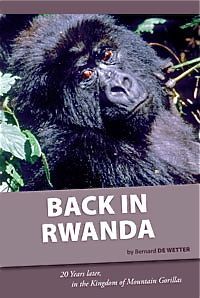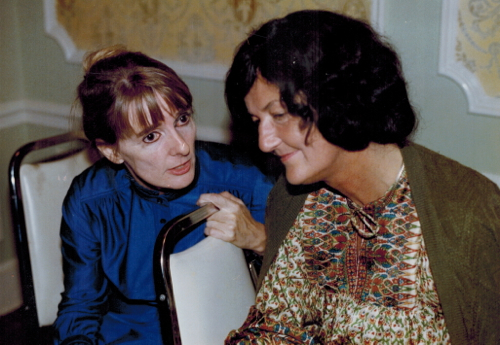The anniversary of the murder of renowned primatologist Dian Fossey came and went on December 26 with only a few mentions on social media sites. Perhaps one of the most fascinating cold cases of modern times, Fossey's murder at her research cabin in the Virunga mountains of Rwanda in 1985 is entering the deep freeze as close friends pass away, memories fade, and interest wanes. As a minor biographer of Fossey -- I consider Farley Mowat's Virunga to be the definitive work -- it was with great interest that I read a review copy of Bernard De Wetter's memoir, Back in Rwanda. A contemporary of Fossey, De Wetter was working for Fossey's nemesis, The Mountain Gorilla Project, for several years in the Volcanoes National Park beginning in 1984. He returned to Rwanda in 2009 and managed a high-end mountain lodge there until 2011.
Part memoir, part conservation guide, and part political analysis of modern day Rwanda, the author does a good job with memoir and conservation, but falls short in other areas. Most regretfully, De Wetter's armchair psychological analysis of Dian Fossey is a disservice to her memory. Like the movie Gorillas in the Mist, roundly denounced as a Hollywood fabrication by Fossey's close friends, this book offers an unflattering, unrealistic, and false portrait of the woman. De Wetter is a good writer, but he did not understand Dian Fossey.
As for the attacks on Fossey's character, it would take more than this column space to address all of them. De Wetter mentions several meetings with Fossey, but in a letter to a friend, written on November 21, 1985 and shortly before her murder, Fossey offers a somewhat different version of one of De Wetter's accounts. The letter is part of the Farley Mowat collection, William Ready Division, at McMaster University.
Someone banged, banged, banged on my front door. I opened it to find a very thin, pale, tall, bearded Belgian fellow (De Wetter) whose greenish face matched his drenched rain gear. He was burdened with a heavy rifle, a panga, and a rain-soaked jacket. It turned out he was a new employee of the MGP (Mountain Gorilla Project), although I had never met him before. The poor, bespectacled man squished into my cabin collapsed near the fireplace, giving me a harrowing tale... By this time the Belgian was in terrible shape -- cold, wet, tired, shaking for good reason -- and the lump on his forehead was getting bigger. I fed him and plied him with a good, stiff drink before sending him back down the mountain with my best tracker.
Fossey wrote the letter in 1985. De Wetter puts the account in 1984. De Wetter also describes a mostly unsympathetic Dian Fossey upon their initial encounter. Which account is more accurate?
More troubling is De Wetter's analysis of the psyche of Dian Fossey, a woman whom he met on a few occasions. He describes her as a friendless loner, when the reality was quite different. Fossey was a prolific correspondent with friends in Rwanda and in the United States. The collection of her letters at McMaster University reveals a very organized, engaged correspondent up until the hours immediately preceding her death. In fact, a letter to her best friend in Rwanda, the late Rosamond Carr, was found in Fossey's field typewriter after the murder. Carr references the letter on page 176 of her book. The letter is a completely coherent "thank you" note and belies De Wetter's thesis that Fossey was a hopeless alcoholic and that an intoxicated state on that fateful night provided the opportunity for her murder.
Carr's book, Land of a Thousand Hills, offers a more complete insight into the personality of Dian Fossey, her friendships, and her use of alcohol.
In a passage that reveals more about the author than Fossey, De Wetter suggests that Fossey may have been attracted to him.
She (Fossey) never seemed to show the least interest in Ingrid (De Wetter's girlfriend at the time), which made me believe that Dian felt some jealousy towards my partner, which prompted her to act as if my girlfriend were non-existent. I often had the impression that Dian Fossey was suffering from a serious lack of love, which she had probably lacked during most of her thrilling but tormented life.
The author also takes great pains to denounce the Canadian author Mowat's book.
I appeared several times in the texts of Mowat's book, without having my name mentioned a single time, the way a meaningless extra would briefly appear in a movie... Did Dian really write in her private diary such negative and sometimes almost denigrating comments about me?
Was De Wetter unconsciously suffering from feelings of rejection by Fossey?
This is where memoir can become an albatross. If one approaches the genre with the knowledge that memoir begins with what one does not remember, admits that honestly, and proceeds to focus on an internal dialogue, it can be successful. Assigning motivations to others, in this case, Dian Fossey, is meaningless.
Shirley McGreal (left) with Dian Fossey in 1981 at an Animal Protection Conference in Los Angeles (Photo copyright courtesy of IPPL and Shirley McGreal)
There are many, many accounts of Dian Fossey that were written by those who knew her well. Two notable examples are within the online archives of the International Primate Protection League, of which Fossey was a member. Shirley McGreal, OBE, is the founder, a contemporary of Fossey, and maintains a personal archive of letters from the murdered primatologist.
Tributes from friends at colleagues can be found here and shortly after her death, here in IPPL archives .
Contacted by email for permission to use the photo in this column, McGreal remembers that Dian Fossey "was very generous."
"Dian, while in the U.S. and sometimes when she was not, sent big Hickory Farms dried fruit gifts to her friends every Christmas," McGreal wrote.
The tragedy of De Wetter's memoir is that the author describes Fossey's murder as "an accident looking like a murder." The forensic evidence is incomplete, except for a brief mention of the hairs visibly clutched in Fossey's hand, presumably from the head of her attacker.
And here is where the cold case begins and ends.
Subsequent Freedom of Information requests to the FBI by this writer in 2005 yielded lab analyses of several of the hair and blood samples from the crime scene. The reports, while extensive, do not offer a conclusion because they were done in 1986, before PCA analysis became standard. Several FOIA requests for access to the actual samples yielded one reply that they "were destroyed," and another that they "were lost."
How the FBI could misplace forensic evidence from one of the most famous cold cases of the century begs an explanation. If these samples could be located, the cold case of the murder of Dian Fossey might be solved.
De Wetter wrote an interesting book about his memories of Rwanda, and the book certainly holds value as an historical piece. His personal observations of Rwandan society before and after the genocide of 1994 are noteworthy. As far as insight into Dian Fossey, and the resolution of her murder, the final chapter has not been written.
Note: This author was granted access to the closed Fossey archives by Farley Mowat. The fonds remain closed until December 2015. Farley Mowat can be contacted through archival staff for permission to use the fonds before it becomes generally open. The second accrual is closed until 2020, although a photocopy with parts of the original letter excised is open.


